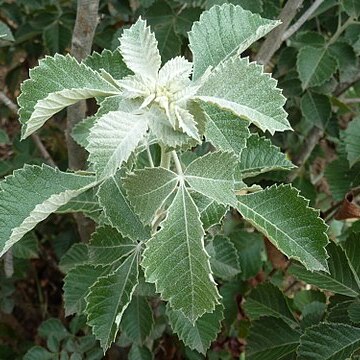Shrub up to 2 m high, branching freely from the base. Bark smooth, reddish; branches erect, somewhat arched, lanate. Leaves trifoliolate, petiolate; petiole lanate, semiterete, flat or slightly canaliculate above (3-)11(-17) mm long; leaflets sessile, coriaceous, slightly rugose, con-duplicate, discolorous, greyish green and thinly villous-lanate above, canescent to white and densely lanate-lumbricate below, hypostomatous; lamina ovate to elliptic, recurved, base obtuse to cuneate, apex acuminate, mucronulate; margin prominently dentate-serrate, teeth mucronulate; venation simple craspedodromous, midrib and secondaries prominent below, impressed above, other veins forming a prominent reticulum above; terminal leaflets (23-)42(-69) x (10-)26(-54) mm, lateral leaflets (13-)25(-50) x (8-)16(-34) mm. Panicles lanate, axillary and terminal, exposed, males up to 180 mm long, subsessile flowers crowded on short side branches. Flowers normal. Drupe asymmetrically rhombic, lenticular, glabrous, dark red, drying brown, 5.0 x 2.1 to 6.8 x 3.2 mm.
Shrub, up to 1.5 m high. Leaves 3-foliolate; leaflets sessile, tending to fold along midrib, margin serrate-dentate, undersurface covered with dense, white to cream-coloured, woolly, persistent tomentum. Drupe dark red, drying brown. Flowers yellowish green.

